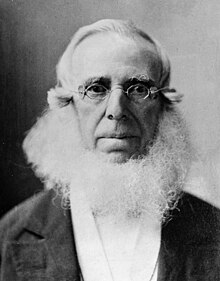Peter Cooper | |
|---|---|
 | |
| Born | February 12, 1791 New York City, U.S. |
| Died | April 4, 1883 (aged 92) New York City, U.S. |
| Burial place | Green-Wood Cemetery |
| Spouse |
Sarah Raynor Bedell
(m. 1813; died 1869) |
| Children | 2, including Edward |
| Signature | |
 | |
Peter Cooper (February 12, 1791 – April 4, 1883) was an American industrialist, inventor, philanthropist, and politician. He designed and built the first American steam locomotive, the Tom Thumb, founded the Cooper Union for the Advancement of Science and Art, served as its first president, and stood for election as the Greenback Party's candidate in the 1876 presidential election.
Cooper began tinkering at a young age while working in various positions in New York City. He purchased a glue factory in 1821 and used that factory's profits to found the Canton Iron Works, where he earned even larger profits by assembling the Tom Thumb. Cooper's success as a businessman and inventor continued over the ensuing decades, and he became the first mill operator to successfully use anthracite coal to puddle iron. He also developed numerous patents for products such as gelatin and participated in the laying of the first transatlantic telegraph cable.
During the Gilded Age, Cooper became an ardent critic of the gold standard and the debt-based monetary system of bank currency, advocating instead for government-issued banknotes. Cooper was nominated for president at the 1876 Greenback National Convention, and the Greenback ticket of Cooper and Samuel Fenton Cary won just under one percent of the popular vote in the 1876 presidential election. His son Edward and his son-in-law Abram Hewitt, both served as Mayor of New York City.